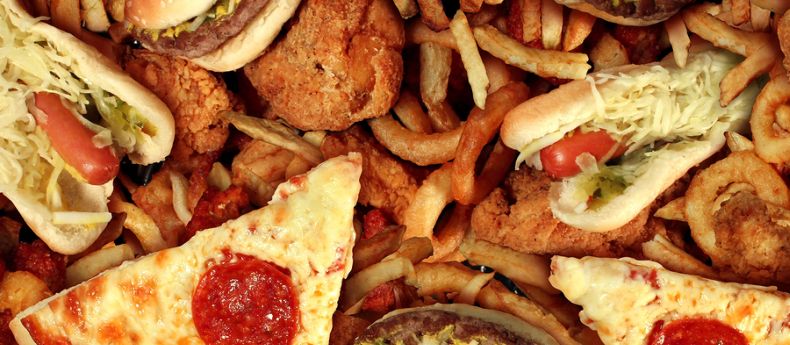
好脂肪与坏脂肪
脂肪好像有个坏名声。食品厂家从几年前就开始用脂肪做文章,以“低脂”作为产品的宣传噱头。注重健康的消费者很容易被吸引甚至迷失在这类营销方式中。然而“低脂”、“脱脂”并不等于健康。在低脂或脱脂产品中,取代脂肪的往往是精加工的谷物或糖,因此并不影响摄入的卡路里含量。此外,过分强调减少饮食中的脂肪量会降低人们进食的满足感,并限制了“好脂肪”的摄入量。
其实,健康的饮食不是避免摄入脂肪,而是要摄入正确类型的脂肪。
脂肪的作用
脂肪存在于坚果、油、黄油、畜产品及乳制品中。我们吃的脂肪储存在脂肪细胞中作为能量储备。人类需要脂肪才能生存,在饥饿或禁食的时候,储备的脂肪能够帮助我们渡过难关。体内堆积在一起的脂肪形成结构脂肪,这些脂肪包裹着器官和神经,让他们保持在各自的位置上,并避免它们受到伤害。例如我们手掌上的脂肪就在保护着脂肪下的骨骼。除此之外,脂肪还能起到保温的作用。
食物中的脂肪对于脂溶性维生素的吸收和利用非常重要,如维生素A,D,E和K及某些植物中的类胡萝卜素(比如西红柿中的红色物质)。因此,减少脂肪的摄入会导致某些维生素的缺乏,正在发育中的孩子尤其需要脂肪来帮助大脑发育。
多少是多?
我们对“人体需要脂肪”这件事上达成了一致,那么人体到底需要多少脂肪呢?2010年美国膳食指南建议,成年人20%到35%的能量应来自脂肪;对于4岁至18岁的儿童,25%至35%的能量应来自脂肪;4岁以下的儿童饮食中应有30%到40%的脂肪。
好脂肪、坏脂肪、有害脂肪
值得一提的是,脂肪也不尽相同。大量数据显示:影响健康的不是脂肪的摄入量,而是脂肪的类型。
有害的脂肪:反式脂肪
尽管一些反式脂肪是天然的,但我们食用的最典型的反式脂肪一般来自经过氢化处理的植物油,例如大豆油。反式脂肪会增加人体内的“坏”胆固醇,减少有益的胆固醇,并干扰有益脂肪如Omega-3脂肪酸的分解。这类脂肪对心脏健康尤为有害。含反式脂肪的典型食品是饼干、蛋糕和油炸食品,应尽量远离这些食品。
坏的:饱和脂肪
饱和脂肪主要来自于动物,在室温下是固体。如果您要食用含饱和脂肪的食物,尽量选择低脂的,例如低脂或脱脂乳制品(例外:对于您的孩子,全脂牛奶和全脂乳品对他们的生长发育至关重要。),但没有必要因此成为素食者以减少饱和脂肪的摄入。吃瘦的肉块,包括里脊肉;选择鸡胸肉而不是鸡的其他部位;去掉鸡、火鸡和其他家禽的皮;烹饪的时候,避免使用黄油和猪油。
研究表明,减少饱和脂肪和反式脂肪的摄入可能降低阿兹海默氏症(老年痴呆症)的患病风险。
好的:不饱和脂肪
不饱和脂肪在室温下呈液状。大多数油都要好过黄油或猪油,不过有两种油对心脏健康尤其有益——橄榄油和油菜籽油(或菜籽油)。此外,多项研究证明鱼油和亚麻籽油(omega-3脂肪酸)可减少患心血管疾病及死亡的风险。其他好的含有不饱和脂肪的食物包括鳄梨、坚果和种子。因此摒弃蛋糕、饼干,选择一盎司的烤坚果作为零食吧!但是不要忘了坚果和种子的摄入量要累计至肉类和豆类的建议摄入量内。
综上所述,吃低脂食物并不是优化健康的最好方式。为了您和家人的长远健康计划,食用不饱和脂肪,并限制反式/饱和脂肪酸的摄入量,可以提高健康的整体水平,特别是心脏健康。打破低脂的神话,选择正确的脂肪!
Copyright United Family Healthcare 2014 All right reserved - 京卫网审[2014]第1927号 - 京ICP备13017554号-4



